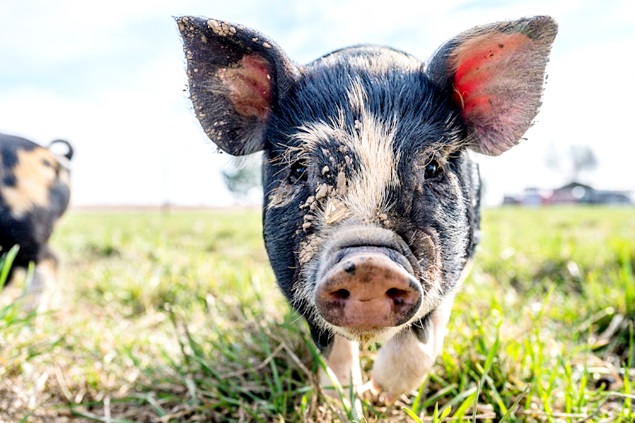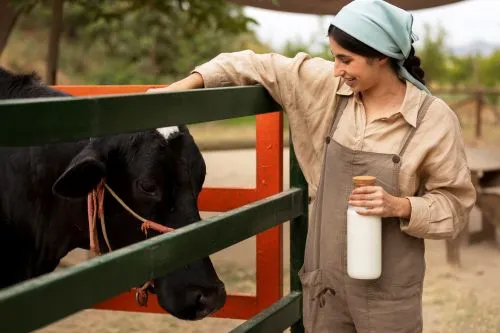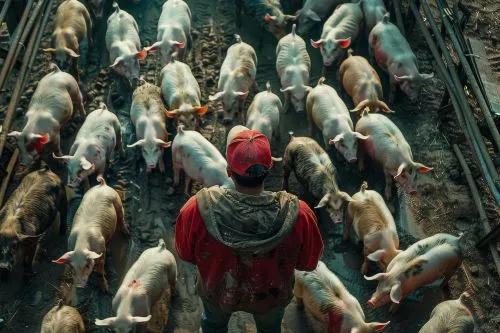
Anyone in the food industry knows that Denmark is a leader in pig production. But how do they achieve such performance? The difference lies in subtleties, as well as in the correct application of all growth technologies. An example for us could be the Danish pig producer Soren Kjaer Poulsen, who focuses strongly on breeding Landrace pigs. With his experienced staff and a new protein strategy, he achieves top performance as well as high levels of animal health. Here's what PigProgress writes about his pig breeding system.
A Successful Farm
Soren Kaer Poulsen, located in Lunderskov, Denmark, is renowned among the most successful pig breeders in Denmark. With about 850 breeding sows, of which 160 are Landrace, he raises approximately 26,000 piglets per year on his Dortheasminde farm.
Poulsen says, "Our breeding production can be divided into approximately 2,000 pure Landrace genetic reserves and another 8,000 that we sell to pig breeders in Denmark and Germany. Additionally, there are boars for collection."
Out of these, about 10,000 animals, mostly males, are finished by Poulsen himself. The rest will be sent to various farms. The farmer runs the farm, which also has 280 hectares of arable land, along with his wife Lone and nine employees. He says, "The basis of our success has been well-trained staff, who have learned to perform as a team and have a shared conviction to continue growing the business."
Three Sites
Poulsen started his business in the 1990s with 250 outdoor-raised sows. In 2002, Poulsen and his wife decided to build a conventional facility for 650 sows in Lunderskov, western Denmark.
In the years that followed, a insemination room was added at the Dortheasminde farm, as well as a rearing facility at a second location, reaching the current size of 850 sows. Additionally, a finishing farm with over 3,000 places can be rented.
"Both the breeding and finishing sites are less than 3 kilometers from the main facility, so it's easy to coordinate work schedules," says Poulsen.
To optimize animal care and operate the pig farms, employees have been assigned individual production zones. In turn, the farm manager, Marlene Svensmark, has worked for Poulsen for almost 20 years. Mainly focusing on the daily management of the farm, she is the primary point of contact for the owners within the pig shelters.
A Strong Team
Gradually, the farmers have formed a true digital community. During working meetings, as well as in Facebook or WhatsApp groups, farmers exchange thoughts and ideas intensely with other farm owners and pig farm managers. With a glint in his eye, Poulsen says, "We might not look into each other's farms, but at the business level, but when we meet, everything is on the table."
A major theme in these discussions is always how to recruit and retain good staff on the farm. Svensmark says, "I'm proud that we have no problems finding employees and that several members of our team have been working here for almost ten years."
Her boss nods and confirms with a smile, "When we renovated the sow houses in 2015, our employees had to find different work for a few months. But as soon as the sows returned, all our employees came back too."
In addition to basics like decent wages and sufficient leave, Poulsen and Svensmark also value a pleasant working environment on the pig farms. A team meeting takes place every day to discuss the task list and evaluations.
During different periods of the year, employees can participate in advanced level courses. For employees with young children at home, the farm aims to create flexible work schedules. Svensmark says, "That's why we are known as a good employer in the industry."
Furthermore, Poulsen says that a strong online presence is essential. On the farm's website, as well as on its Facebook page, images can be viewed, such as a shared breakfast or preparation in the cafeteria. Moreover, the website also features professional farm videos, such as pig houses and drone footage of the rapeseed harvest.
Operating the Breeding Unit
Since the complete renovation five years ago, the sow farm has been operating well under its experienced team. So Poulsen decided to engage in a multiplication unit as well. About 2.5 years ago, Poulsen became one of the approximately 30 farms in Denmark that breed animals for the national DanBred breeding program.
Multiplication certainly requires more management than simple piglet production for commercial use. For example, it involves extensive documentation and evaluation analysis.
Each breeding animal in the herd has its own selection index, which describes the value of its production based on weighted genetic factors of feed utilization, daily gain, foot condition, and the number of live pigs on bedding on day 5 post-farrowing.
Personal Breeding Goals
In addition to these superior breeding goals, Poulsen has defined four key objectives:
• Longevity: All sows will be kept in large groups, with ad libitum feeding. Poulsen and Svensmark have been paying attention for years to sows that do a decent job, and therefore, they spend a lot of time on the farm.
• Farm Hygiene - the sow farm has an unrestricted red status, without specific pathogens (SPF). Poulsen explains, "This is the highest level of health given in the Danish SPF system. It means that the breeding facility is free of certain dangerous pathogens, such as mycoplasma and the Porcine Reproductive and Respiratory Syndrome virus. To maintain this status, in addition to SPF hygiene rules, he has added UV light sources to the air inlets.
• Customer Orientation - Poulsen and Svensmark are always available to discuss with their customers and try to meet their wishes. That's why insemination doses are offered at different ages and with different vaccination statuses.
• Intestinal Health - Poulsen says, "Besides correct vaccine management, we want to build up a balanced gut flora using feed management. In this process, raw materials, feed hygiene in liquid feeding equipment, and feed structure all play an important role."
Thanks to the farm's comparative values and conversations with other sow breeders in his network, last summer, the breeder felt that especially in the farrowing room, improvements could be made. Poulsen:
"We have to consider that we work with purebred sows and not just F1 sows." However, with 29.3 piglets weaned per sow per year, he was not satisfied. A pre-weaning mortality of 20% was too high for him.
"At that time, we had big problems with milk supply for the newborn piglets. Therefore, we decided to install a completely automatic milk cup system," says Svensmark.
It turned out to be a step in the right direction, as with the new technology and high-quality milk replacer, the average weaning weight could be increased by about 700 grams. To achieve this, fewer sows needed to be foster mothers than in the past.
Nutrition with Fermented Algae
Another starting point was a new protein strategy in sow nutrition. In October 2019, the original components of crude protein from sunflower and sugar beet were replaced with the animal feed additive EP199, produced by European Protein.
This protein component is designed for sows and consists of fermented seaweed and rapeseed. The breeding farm mixes the ingredient through the sow rations at 4% for gestating sows, and 9% for lactating sows. Svensmark says:
"The most remarkable changes in the pig shelters are the improved feed intake of lactating sows, as well as the consistency of the bedding. I'm convinced that our sows give more milk since the feed was changed."
According to Poulsen, the pretreatment of the protein components is crucial. He says, "We benefit from the positive effects of feed fermentation on gut flora, without having to put much effort into management and technology."
Figures from the sow management system confirm both experts' observations. Currently, 32.7 piglets are weaned per sow, and pre-weaning mortality has decreased to 14%.
Poulsen is content, saying, "Together with the installation of the milk cup system, we could increase the average weaning weight after 28 days by 1.4 kg, to 6.5 kg." With these figures, the additional cost of the protein component of about 30 euros per sow per year is economically feasible.
No Zinc Oxide and Antibiotics
For breeding sows, the farm has been using fermented products for six years. Poulsen uses the fermented dry protein EP100i, based on pure rapeseed meal, which, like the lactating sow solution, contains 34% crude protein and 5% lactic acid.
Due to the limited proportion of anti-nutritional factors, the animal feed additive is highly digestible. Therefore, Poulsen aims for a ratio of about 15% for breeding sows, a percentage that gradually decreases to about 8% as the phase progresses.
Additionally, it is clear that there is no difference in weight between groups, and the animals appear healthy. For pig producers, this is a huge advantage, not only when the breeding pigs are ready for marketing.
Since 2017, the Danish pork processor Danish Crown has banned the use of antibiotics in the breeding phase as part of its antibiotic-free pig growth program. Additionally, the company has already indicated that breeding pigs should not rely on the use of zinc oxide.
For not using antibiotics and zinc oxide, Poulsen receives a premium of 0.20 euros and 0.05 euros/kg, respectively, in addition to the animal's price. He says:
"These limitations shouldn't come at the expense of animal health. And with us, it doesn't, as can be seen from the pre-weaning mortality rate of 1.2% in the rearing phase." In cases where antibiotic use is inevitable with an individual animal, that animal is marketed separately.




